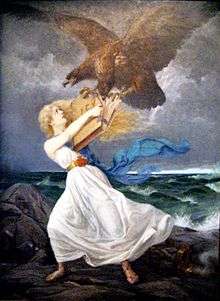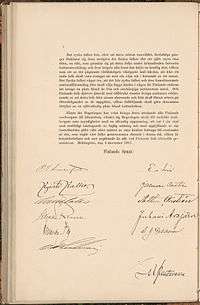Independence of Finland
Finland declared its independence on 6 December 1917. The formal declaration of Independence was only part of the long process leading to independence of Finland.
Promises of Empress Elizabeth (1742)
The subject of an independent Finland was first mentioned in the 18th century, when present-day Finland was still ruled by Sweden. Following the Russian occupation in the Russo-Swedish War (1741–1743) the Elizabeth of Russia made vague promises of making the country independent. This led to preparations to create a Kingdom of Finland in 1742. Finns elected the then Duke Peter of Holstein-Gottorp (who later became heir to the throne of Russia and tsar as Peter III) as the King of Finland. However, the political situation had outgrown the idea of Finnish independence and it quickly evaporated.[1]
Birth of a nation

Before a nation declares independence, it must develop a national identity and certain institutions. Governing bodies for Finland were developed after 1809, when it was “elevated as a nation among nations” (as declared by tsar Alexander I) by becoming an autonomous grand duchy under the Russian tsar. The Diet of Finland was meeting regularly since 1863. In 1906 the unicameral Parliament of Finland was created, with universal and equal suffrage.[2]
National identity grew at same time with Pan-European nationalism. Johan Ludvig Runeberg and Elias Lönnrot created an idealized image of Finnish people and Finnish nature in the 1830s and 1840s.[3] Also J. V. Snellman was a central person in national romanticism and the modern nationality debate. He encouraged use of Finnish language (instead of Swedish) among the educated classes.[4]
In 1901 Russia tried to alter the nature of the Finnish army with the new conscription law, which demanded Finns not only to defend Finland but to fight for Russia on any front. Finnish resistance grew into a mass movement, and only half of eligible men reported for duty.[5]
Second period of Russification of Finland and World War I got different activist groups to unite. Jäger Movement sent first 200, later 1900 volunteers to Germany to be trained as Jägers (elite light infantry), for armed resistance.[6]
Discussions in 1917
Revolution in Russia
The February and the October Revolution in 1917, had also ignited hopes in the Grand Duchy of Finland. After the abdication of Grand Duke Nicholas II on 2 March (15 March N.S.) 1917, the personal union between Russia and Finland lost its legal base – at least according to the view in Helsinki. There were negotiations between the Russian Provisional Government and Finnish authorities.
Power act
The resulting proposal, approved by the Russian Provisional Government, was heavily rewritten in the Finnish Parliament and transformed into the so-called Power Act (Finnish: Valtalaki, Swedish: Maktlagen), whereby the Parliament declared[7] itself to now hold all powers of legislation, except with respect to foreign policy and military issues, and also that it could be dissolved only by itself. At the time of the vote it was believed that the Provisional Government would be quickly defeated by the rebellion in Saint Petersburg. The Provisional Government survived, however, disapproved of the Power Act and dissolved the Parliament.
After new elections and the ultimate defeat of the Provisional Government in the October Revolution, the Finnish Parliament decided to set a three-man regency council, based on Finland's Constitution, and more precisely on §38 of the old Instrument of Government of 1772, which had been enacted by the Estates after Gustav III's bloodless coup. This paragraph provided for the election of a new monarch in case of the extinction of the royal line and was interpreted in Finland as vesting sovereignty in the estates, later the Parliament, in such an interregnum. The regency council was however never elected because of the strong opposition of Finnish socialists and their general strike which demanded for more radical action.
On 2 November (15 November N.S.) 1917, the Bolsheviks declared a general right of self-determination, including the right of complete secession, "for the Peoples of Russia". On the same day the Finnish Parliament issued a declaration by which it assumed, pro tempore, all powers of the Sovereign in Finland.[8]
The old Instrument of Government was however no longer deemed suitable. Leading circles had long held monarchism and hereditary nobility to be antiquated, and advocated a republican constitution for Finland.
The Declaration and 15 November


Pehr Evind Svinhufvud formed a Senate which started on 27 November 1917. Its goal was to execute independence as soon as possible. The Senate came back to the Parliament with a Declaration of Independence and proposal for a new republican Instrument of Government on 4 December. The Declaration of Independence was technically given the form of a preamble of the proposition, and was intended to be agreed by the Parliament. Parliament adopted the Declaration on 6 December.
With reference to the declaration of 15 November, the declaration says:
The people of Finland have by this step taken their fate in their own hands; a step both justified and demanded by present conditions. The people of Finland feel deeply that they cannot fulfil their national and international duty without complete sovereignty. The century-old desire for freedom awaits fulfilment now; Finland's people step forward as a free nation among the other nations in the world. (...) The people of Finland dare to confidently await how other nations in the world recognize that with their full independence and freedom, the people of Finland can do their best in fulfilment of those purposes that will win them a place amongst civilized peoples.
International recognition
Svinhufvud asked immedeately Sweden, Norway, Denmark, Germany and France to recognise Finland's independence. The West however said they will wait until the former ruler, Russia, has recognised the declaration. They told Svinhufvud to talk to Bolshevik Government lead by Lenin. Svinhufvud was hesitant to do this, as he did not want to recognise the Bolsheviks as legal rulers of Russia. Besides he thought that the bolshevik government would probably fall soon. So the parliament decided to ask for recognition from the Russian Constituent Assembly. Germany, which was in middle of peace negotiations with Soviet Russia, strongly encouraged Finns to talk to Lenin and Council of People's Commissars. Svinhufvud followed their advice, as Finland wanted Germany's recognition as soon as possible.
On 18 December (31 December N. S.) the Soviet Russian government issued a Decree, recognizing Finland's independence,[9] and on 22 December (4 January 1918 N. S.) it was approved by the highest Soviet executive body, the All-Russian Central Executive Committee (VTsIK).[10]
Organizing a new country
Hardship burdened the common people, which already had resulted in alarming polarization, and soon would ignite the Civil War. The declaration actually addresses this problem:
The Government will approach foreign powers to seek the recognition of our political independence. All the complications, famine and unemployment ensuing from the present external isolation make it urgent for the Government to tie direct contacts with foreign powers without delay. Urgent, concrete assistance in the form of necessities for living and industry is our only rescue from imminent famine and industrial standstill.
Many of the necessary ministries and authorities had been founded during years of autonomy, and they continued their activities perhaps after a change of name. Bank of Finland had the same position as before. As pilotage has military significance, the National pilot office had been a subject of russification. National Board of Navigation, later called Finnish Maritime Administration was founded 15 December 1917, and piloting became its responsibility.[11][12]
The attempt to establish a monarchy in Finland was not successful, and 1919 Kaarlo Juho Ståhlberg became the first president. First parliament elections were held in March 1919.
National symbols

The parliament selected among several suggestions a blue and white flag, and the new flag of Finland was rising over house of parliament 28 May 1918.[13] Coat of arms of Finland with crowned lion on a red field had been used already in years of Swedish rule.[14]
Selection of National anthem became one subject of class distinction. The conservatives preferred Maamme by Runeberg and Pacius, while the working class was singing La Marseillaise and The Internationale. After the whites won the Civil war, Maamme was accepted as the national anthem.
6 December was later declared as the national holiday Finland Independence Day. The bill to make Finland a republic was ultimately passed by the Diet in 1919.
Commemoration
The 90th Anniversary of Finland's Declaration of Independence was selected as the main motif for the €5 90th Anniversary of Finland's Declaration of Independence commemorative coin, minted in 2007. The reverse shows petroglyph aesthetics, while the obverse has a nine-oar boat with rowers as a symbol of collaboration. Musical symbols and Finnish kantele strings are also distinguishable in the coin's design.
See also
References
- ↑ Singleton, Fred (1998). A Short History of Finland. Cambridge University Press. p. 51. ISBN 9780521647014.
- ↑ "Parliamentarism in Finland". Finland.fi. Retrieved 12 June 2016.
- ↑ Matti Klinge. "Runeberg, Johan Ludvig (1804 - 1877)". The National Biography of Finland. Retrieved 12 June 2016.
- ↑ Klinge, Matti. "Snellman, Johan Vilhelm (1806 - 1881)". The National Biography of Finland. Retrieved 12 June 2016.
- ↑ "The Russian Empire". Finland: A Country Study. Library of Congress. 1988. Retrieved 26 December 2016.
- ↑ "The Finnish Jaeger Movement". Embassy of Finland, Riga.
- ↑ "Hallituksen esitykseen, joka sisältää ehdotuksen laiksi erinäisten asiain siirtämisestä Suomen senaatin ja kenraalikuvernöörin ratkaistavaksi" (in Finnish). 25 July 1917. Retrieved 8 February 2014.
- ↑ "Eduskunta". Suomi 80 (in Finnish). Tampere University. Retrieved 20 August 2016.
- ↑ "Primary Documents - Soviet Recognition of Finland's Independence, 18 December 1917". first world war. Retrieved 20 August 2016.
- ↑ "On This Day - 4 January 1918". first world war. Retrieved 20 August 2016.
Eastern front: Bolshevik Government recognises independence of Finland.
- ↑ "Autonomian ajan viranomaiset". Arkistojen portti (in Finnish). Archives of Finland. Retrieved 26 December 2016.
- ↑ "Finland - International Hydrographic Review". Centre for Digital Scholarship Journals. Retrieved 26 December 2016.
- ↑ "Quirks of history: Finnish flag created in a restaurant back room?". Suomifinland100. Retrieved 12 June 2016.
- ↑ "Coat of Arms". finland.fi. Retrieved 26 December 2016.